Hillman Helicopter Designs
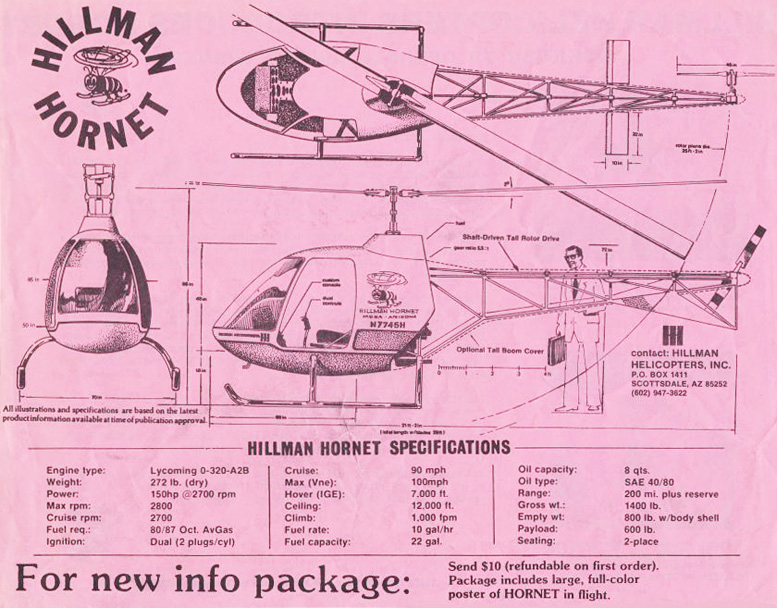
DOUG HILLMAN sets his sights high. Twenty years ago, before the Hillman Hornet, barely out of his teens, Doug parlayed a keen interest in scuba diving into a successful diving salvage operation at Morro Bay, California.
He made headlines that year by recovering a wrecked Consolidated B-24 Liberator from Huntington Lake in the High Sierras, where it had crashed during a 1943 snowstorm. Ten years later he was big in aerospace as a senior systems analyst/engineer, and later as a crop duster flying Stearmans.
But Doug abandoned those pursuits to develop the world’s first Wankel rotary-engine-powered kit helicopter, the Wankelbee. that first flew in July 1975 Hillman settled down finally at Falcon Field, near Mesa, Arizona, and surveyed the sport helicopter market more closely.
Douglas Hillman developed WankelBee helicopter with rotary combustion engine (first flown 1975).
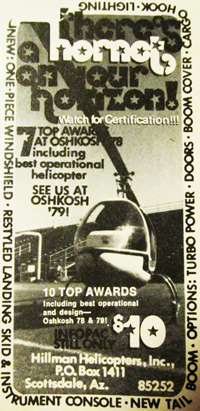
There was a real challenge there, he saw, and competition was light Pop Emighs Helicom had been sold to International Helicopters in Mayville, New York, while a neighbor. B J Schramm, was busy over in Tempe cranking out Scorpion helicopters.
What the market needed, he saw, was not just another chopper for the mass market but a quality machine that could be sold in kit form for a few bucks under $30,000 And it should. Hillman knew, offer performance comparable to that of the best certificated whirlybirds.
like the Hughes 300 The result of his work was not unexpected to Hillman Oshkosh the Hillman Hornet won the Best Operational Helicopter award, and production at Falcon Field moved into high gear with a goal of 10 complete kits a month.
Fasy to fly and attractively designed, the Hornet helicopter is powered with the certificated Lycoming 0-120-A2B four-cylinder aircraft engine that delivers 150 hp It in owner assembled under a factory-supervised program that also offers flight training.
Weighing 272 pounds dry, the Lycoming delivers its rated thrust at 2700 cruise rpm and burns 80/87 octane fuel. Empty weight is 800 pounds, including a fiberglass body shell, and gross weight is 1400 pounds. So payload is 600 pounds, including two occupants.
Performance figures include 90 mph cruise; 100 mph VNE; 7000 foot hover (IGE); 12,000-foot ceiling; 1000 fpm climb; 200 mile range plus reserve on 22 gallons, at 10 gph. Says Hillman: “The bottom line with the Hornet is quality. We’ve been working more than 10 years toward providing the best possible product, and the design integrity of the all-new Hornet helicopter is second to none.”
After Douglas Hillman developed WankelBee helicopter with rotary combustion engine (first flown 1975) and two-seat Hornet (first flown 1978), Hillman Helicopter designed Model 360 as three-seat utility helicopter of very modern design which first flew 1981.
As featured at the 1979 Oshkosh EAA Convention, the Hornet is now turbocharged and is lighter, faster, and much improved over the 1978 model, according to Hillman. He reports It features aerodynamic and drive provisions which can be seen in wide application throughout the certificated helicopter industry.
“At Hillman Helicopters Inc, we don’t try to reinvent the wheel, but offer the best possible helicopter in the economy field by improving upon time-tested engineering principles. Where innovations are required, our available expertise includes the best engineering consultants in the world.”
Now the big news is that the Hillman Hornet helicopter is scheduled to begin flight testing next month for normal category type certification, with the goal of achieving an Airworthiness Type Certificate (ATC) in the summer of 1980, at which time kit sales will terminate.
VIDEO: Hillman Hornet
ABOVE: Homebuilt demo at Mesa, Arizona (late 1970s) & display at Helicopter Expo. in Las Vegas (early 1980s).
Hillman
Doug Hillman/Rotor Sport Inc, Falcon Field, Mesa AZ. 1981: Hillman Helicopters, Paso Robles CA and Stellar Airpark, Chandler AZ. 1983: Operations ended when Hillman and brother, Ron, were killed by a drunken driver.
Hillman 360 Helicopter
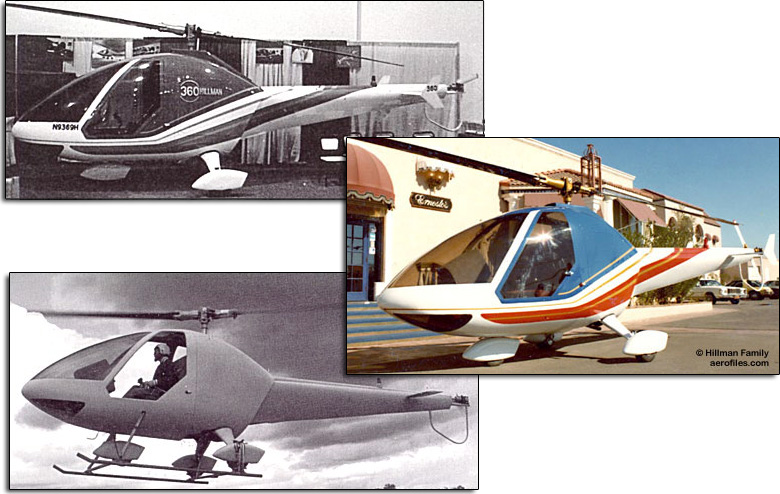
NOTES: Hillman Model 360 – 1981 – 205hp Avco Lycoming HIO-360-C1A; load: 1100lbs; speed: 130/115/0; range: 560miles; service ceiling: 15,000′; construction: 10/15/81. Rudy Enstrom. Fiberglass shell, fiberglass blades with stainless-steel leading edges, metal airframe. Quantity built: 1 [N9360M]. Optional equipment included spray rig, cargo and stretcher racks, floats
Busy Bee Helicopter (Busybee)
Busy Bee 1975; Mazda RX-3; no other data.
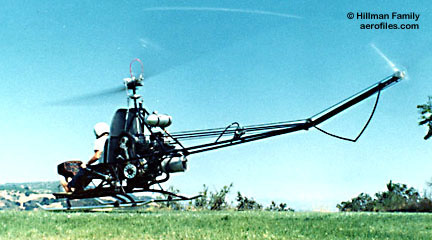
Photo date – 7/18/75 Hillman Busy Bee Mazda rotary RX 3 powered helicopter.
EDITOR: The obvious lines appear to be the mechanics of a Rotorway Scorpion One helicopter fitted out with the Mazda rotary engine.
Hillman was looking at ways to improve an existing design which would ultimately end up as a “new helicopter”.
This improvement was was ahead of it’s time for a Rotorway modification – with many now being converted to Subaru power.
The Scorpion helicopters can still be found all over the United States very cheap and are an excellent starting point for the would-be home builder and experiments.
Hillman Hornet and Turbo Hornet Helicopter

Hillman Hornet – Turbo Hornet 1977 – 150hp Lycoming O-320-A2B; rotor: 25’2″; length: 29’0″; load:600lbs speed: 100/90/0 range: 276 miles; service ceiling: 12,000′; construction: 11/19/77; Quantity: 80 sold in kit form by Sep 1978. Prototype [N44JA] nicknamed Green Hornet for its color. EAA Best Operational Helicopter award 1979. Turbo option added in 1979.
Hillman Wankelbee Helicopter(Wankle Bee)
Wankelbee 1977 – No data; rotary powered. [N17165].
READ MORE AT AVIASTAR: Here
Douglas Hillman was an enthusiastic amateur builder who carried out several helicopter experiments in the 1970s and built the Hillman Wankel-B helicopter, and then the two-seat Hillman Green Hornet and Turbo Hornet IIA helicopter. In 1979, Hillman joined Rudolph Enstrom to develop the Hillman 360 helicopter.
This streamlined three-seat light helicopter bore some resemblance to Enstrom’s earlier designs with a fully enclosed fibreglass and metal fuselage, tricycle undercarriage and a Lycoming HIO-360-C1A piston engine driving a two-blade rotor.
The prototype was built at Stellar Air Park near Phoenix, Arizona, and flew on 15 October 1981. Unfortunately, Douglas Hillman died during the period of testing of the Model 360 and the design was abandoned.
The above info mentions that Douglas Hillman died during the testing phase of the helicopter. Actually, according to Jim Bryant, who designed the fuselage and paint trim scheme, Hillman and his son were killed by Tenny Jo Cooper, a female drunk driver who plowed into them when they pulled off the road to change a flat on the trailer hauling the Model 360.
Technical Data For Hillman 360 Homebuilt Helicopter
-
ENGINE: Avco-Lycoming H10-360-C1A rated at 155kW
-
MAIN ROTOR DIAMETER: 8.15m
-
LENGTH: 9.47m
-
TAKE-OFF WEIGHT: 1000kg
-
Maximum Speed: 185km/h
-
RANGE: 2500km
DETAILS: 1981 – Fiberglass shell, fiberglass blades with stainless-steel leading edges, metal airframe. Optional equipment included spray rig, cargo and stretcher racks, floats.
Amateur aircraft designer’s dreams took flight at Falcon Field
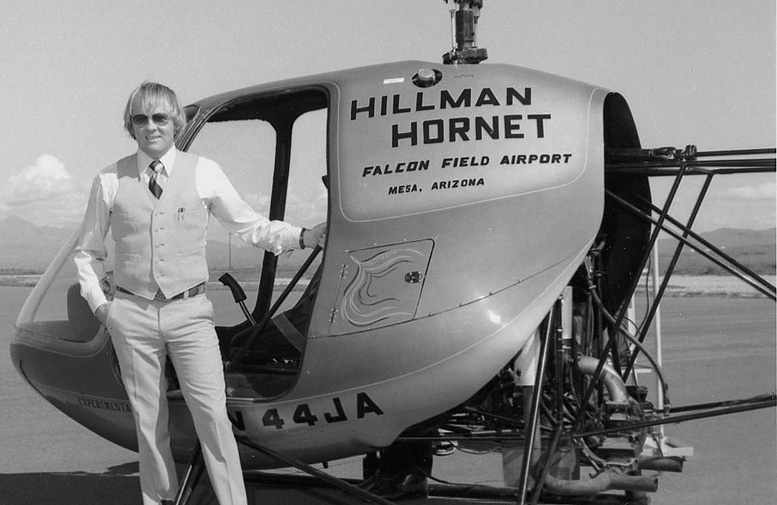
Shortly after moving his operations from Paso Robles, California, to Mesa in 1978, amateur airplane designer Doug Hillman proudly posed next to a prototype of his Hillman Hornet personal kit helicopter. (Photo: Tempe History Museum)
Jay Mark, Special for The Republic | azcentral.com Published 7:00 a.m. MT Aug. 24, 2017
Mesa history: At age 32, Douglas Hillman began serious work on building an affordable, personal helicopter that could be assembled from a kit.
This is a story that has a lot of buzz to it
It starts with an undated photo discovered in the vast collection of the Tempe History Museum. I couldn’t help but be intrigued.
Pictured is a handsome, dapper-dressed dude wearing dark aviator sunglasses; proudly standing on the landing skid of a tiny, wiry helicopter with “Hillman Hornet Falcon Field Airport Mesa, Arizona” emblazoned on the side.
What a great name for helicopter
As a pilot who trained at Falcon Field, I am particularly fascinated by a close-to-home aviation mystery.
The man in the photo
The man in the photograph was Douglas Hillman.
Born in 1937 in Paso Robles, California, not much is known about Hillman’s early years. Except like many boys he developed a passion for speed and flying.
He began by racing motorcycles and stock cars. Along the way, Hillman earned a pilot’s license and began a flying career as a crop-duster, a low-flying, heart-in-the-throat occupation.
A 1978 newspaper article reported that Hillman, by the time he was 30, “…. used to fantasize about flying to the top of the highest mountain in sight to have a picnic with his wife.”
With the least expensive helicopter at the time priced at $80,000 (about $475,000 in today’s dollars) it was only a dream for someone on a modest income.
An affordable helicopter
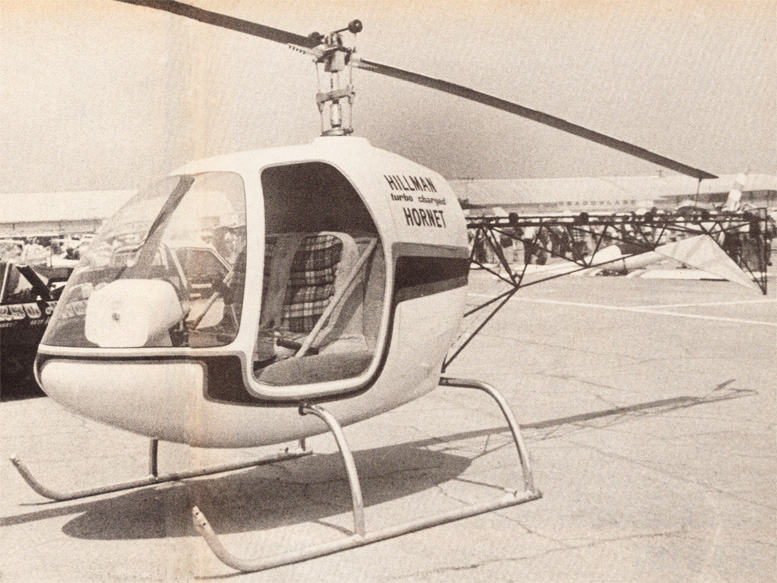
At age 32, amateur designer Hillman began serious work on building an affordable, personal helicopter that could be assembled from a kit. Able to convince a number of investors to back him, Hillman had a flying prototype by 1978.
Things looked good for the Hillman Hornet, as it was named. The goal was to offer a two-seater capable of cruising at 90 mph on 7.1 gallons per hour of fuel, all at a relatively affordable cost of $18,500 (about $66,000 today).
The helicopter still needed more work before it would be market ready. That’s when Hillman learned through a friend that more expertise was available right here in the Valley. After a brief scouting visit, he moved his family to Tempe and operations to Falcon Field.
Engineering help
It just so happens Rudy Enstrom lived in Phoenix. In 1959 the former mining engineer started the R.J Enstrom Corporation to build a helicopter similar to Hillman’s.
But soon after Enstrom found investors, he was booted from his own company — forcing him to abandon his dreams to become a heating contractor — until meeting Douglas Hillman, who hired Enstrom to be his Chief Engineer.
The Hillman Hornet Helicopter was announced to the world with a positive reception in 1978 — earning that year’s “Overall Award” at the Oshkosh, Wisconsin Experimental Aircraft meet and the “Best Helicopter Design Award” at the Popular Rotorcraft Convention in Rockford, Illinois.
Two years later, claiming pre-orders for 16 Hillman Hornets, Hillman and Enstrom were close to putting their kit plane on the market.
So, what happened next? Are Hillman Hornets still flying today? There is a tragic twist to the story. That’s for next week.
Reach historian Jay Mark at jaymark@twtdbooks.com
A tragic end for the Hillman Hornet
Jay Mark, Special for The Republic | azcentral.com Published 2:28 p.m. MT Aug. 29, 2017
When we left off last week, Doug Hillman, a transplant from Paso Robles, California was getting ready to launch an affordable two-seat personal helicopter he called the Hillman Hornet.
In September 1978, a prototype Hillman Hornet had its first successful flight in Paso Robles. Needing expertise he didn’t have, Hillman was persuaded to move to the Valley and set up operations at Falcon Field.
While here, the amateur aircraft designer and builder enlisted an experienced Valley resident, Rudy Enstrom, to be his chief engineer.
With Enstrom on board, the handsome Hillman, cutting an aviator’s appearance with his blond hair and Ray-Ban sunglasses, was the perfect the face for the company.
Legal troubles
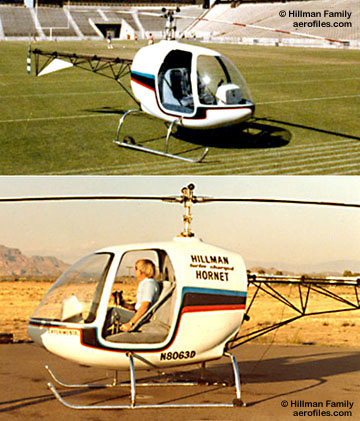
Aviation enthusiast Doug Hillman is seen above in at Falcon Field in his Hillman Hornet two-seat helicopter. A Turbo Hornet is seen in the top photograph. Development the Hillman helicopters came to a halt in 1983 when Hillman and his son were killed in a hit-and-run accident in Gilbert. (Photo: Hillman family photo/Aerofiles.com)
Even before he had a product to sell, Hillman was busy promoting. Maybe a bit too much.
In April 1980, the securities division of the Arizona Corporation Commission accused Hillman of selling unregistered securities, a violation of “the Arizona Securities Act by offering limited partnerships in Hillman Helicopter Associates without registering them with the Corporation Commission.”
In addition he was “under investigation for the offer or sale of franchises in violation of the Arizona Consumer Fraud Act.”
All evidence indicates that Hillman seriously planned to market the Hillman Hornet, an $18,500 kit helicopter. Apparently short of funds, he was accused of crossing the line by misrepresenting how close the Hillman Hornet was ready for sale.
So far, research has not shown how the case was adjudicated.
Hillman continued working on a line of helicopters, from the Hillman Hornet to the Hillman 360.
Fate intervenes
In fact, Hillman Helicopters seemed close to taking off, so to speak. Until the fateful day, July 21,1983.
Doug Hillman and his 25-year-old son, Ron, were driving a pick-up towing a trailer with a Hillman Hornet on it. According to a newspaper account, Gilbert police officer Les May, who was on his way to work, saw “the two men…standing on the shoulder of the road beside the pickup…”
on which they seemed to be working.
A car travelling about 45-50 mph “approached and veered onto the shoulder of the road 100-150 feet behind the pickup.”
May recalled, “it didn’t slow down at all. It just kept coming toward them, and it kept on going after it struck (and killed) them.”
“Tennie Jo Copper, 21, was caught and arrested for DUI, manslaughter and hit-and-run.” She was convicted and sentenced to 10 years in prison.
The aviation world was stunned by the tragedy that ended Hillman Helicopters. Senator Barry Goldwater said, “… Doug was the last person in this world with all of his skill and his speed, ever to be caught on a highway with another man and the other man being drunk. He was a fine, wonderful man, and we are all going to miss him.”
It is believed that a couple of Hillman Hornets have survived. To honor Doug Hillman’s efforts, aviation enthusiasts hope to restore them to flying condition.
Reach historian Jay Mark at jaymark@twtdbooks.com
Photos From The Vault
Doug Hillman and his Hillman Hornet
by David Middlecamp
Close your eyes and imagine your ultimate all terrain vehicle.
-
Light enough to transport on a small trailer: ✔ Check.
-
Affordable: ✔ Check.
-
Easy to park: ✔ Check.
-
Flys to 1,200 feet: Whaaaaaa?
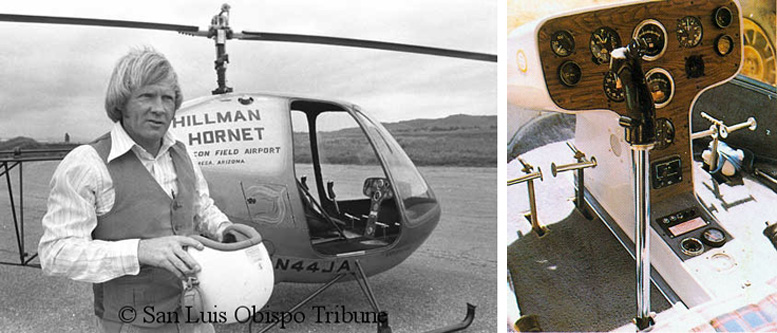
Doug Hillman stands in front of his creation, the Hornet, at San Luis Obispo airport. ©The Tribune/ Jeanne Huber.
The dream began in Paso Robles – Affordable flight
Doug Hillman turned the grail of affordable flight into reality. Friends remember him as a visionary builder who had a contagious energy and enthusiasm.
According to the Plane&Pilot website the Hillman Hornet received the “Best Helicopter Design Award” at the Popular Rotorcraft Convention in Rockford, Illinois. The flight performance of the Hornet drew favorable comparisons to the Hughes 300.
Not bad when an amateur designer can compete with a billionaire’s aircraft company. At one time plans were being made to manufacture the helicopters in Paso Robles.
Sadly Doug Hilman and a son, Ron, were killed by a hit and run drunk driver July 21, 1983 as they prepared to drive to an airshow to demonstrate the Hillman Hornet.
This story is from the then Telegram-Tribune on April 14, 1978.
Hillman Hornet Helicopter
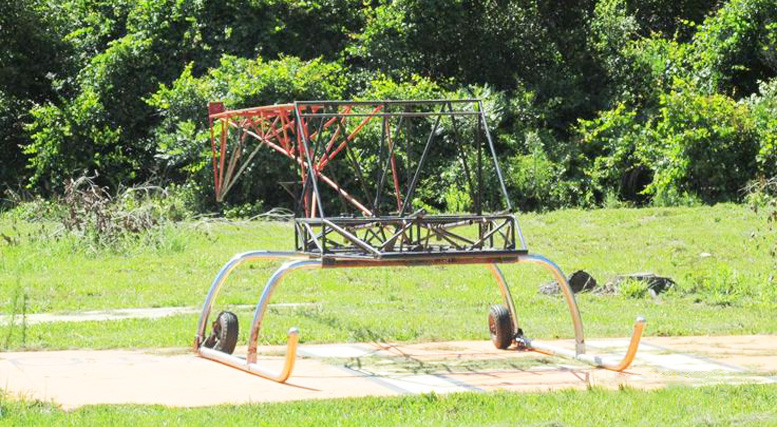
Build-it-yourself helicopter debuts in SLO
Story and photo By Jeanne Huber
Doug Hillman says he used to fantasize about flying to the top of the highest mountain in sight to have a picnic with his wife. But the way to get there was in a $80,000-plus helicopter, so the fantasy didn’t seem to have much of a chance.
That didn’t stop Hillman. Backed by thousands of dollars from 10 San Luis Obispo County investors and an equal number from throughout the state, Hillman has developed the “Hillman Hornet,” an $18,500 build-it-yourself helicopter.
He flew his prototype around the San Luis Obispo County Airport Thursday so a reporter and some of his backers could see it perform. The craft is small and light enough to be towed down the road on a trailer behind a van.
Two people can roll it off the trailer and get it ready. And then anyone with a helicopter pilot’s license can get 1,200 feet up for a view of the land. Hillman said the Hornet can cruise 90 miles on 7.1 gallons of fuel in an hour.
He said the helicopter uses far less fuel than conventional aircraft. The Hornet can lift 600 pounds, including fuel, passengers and baggage. It weights 1,000 pounds, and Hillman said he hopes to pare 200 pounds before the Hornet goes into full production.
Hillman, 39, started designing the Hornet seven years ago when he lived in his native Paso Robles. He’d raced Motorcycles and Stock cars for years, so he knew something about machinery and design. He’d also logged many hours of flight time in regular small planes working as a crop duster.
But always in the back of his mind there was that fantasy: “I wanted to be able to fly to the top of that mountain over there and have a picnic. But it was just too expensive.” So Hillman embarked on his project, an effort that’s not been easy at times. He had nine children to support.
Hillman said he started to design the helicopter in Paso Robles, but was continually making trips to Los Angeles to seek specialists with knowledge he did not have. He thought about moving to Southern California but found the suggestion “abhorrent.”
Once he went to Arizona to consult a friend in the helicopter business, and discovered that many of the specialists he needed were located there. So he moved his family and business to Mesa, Arizona.
The project received a boost recently when he arranged to buy out another small helicopter company with a well proven drive train. The drive train is the key device which makes a helicopter a helicopter. It transfers the motor’s torque into the spin of the blades.
Hillman’s Hornet is designed like the model produced by the company he bought out, but it’s far more attractive. The first Hornet was completed in September and by the end of its flight in San Luis Obispo Thursday had logged 59.7 hours in the air.
illman said the Federal Aviation Administration certified it airworthy Friday. It is classified as an experimental craft, which means it can’t be flown for hire. It can fly in all the same places and use the same landing areas as conventional craft, however.
Hillman said he has orders for 16 of the helicopters and plans to begin production as soon as he gets nine more. The initial price will be $18, 500. He said he hopes to produce the helicopter at the Paso Robles Airport.
Buyers must be willing to invest more than money, however. The choppers will arrive as a bunch of parts in boxes. It’ll take an experienced mechanic about 400 hours to assemble them into a Hornet.
| USA Hillman Helicopters Hornet IIA | |
|---|---|
| General | Two-seat helicopter, derived from kitbuilt Hornet and intended to meet FAR Part 27 certification standards. |
| History | Aircraft designed by Doug Hillman in collaboration with Rudy Enstrom as a development of the original Hillman Hornet. The prototype first flew in September 1977. The Hornet won the award of Best Operational Helicopter at Oshkosh ‘78 and Outstanding Design in ‘79. The project was superseded by the Model 360. The death of Mr. Hillman stopped all work on the project. |
| Rotor System | Two-blade main rotor with tapered chord rotor blades. Two-blade tail rotor with tailstrike protection. |
| Fuselage & Tail | Braced tubular structure with glassfiber fairings. |
| Landing Gear | Tricycle gear with all wheels faired over. Floats optional. |
| Optional | Cargo hook for external (sling) loads. |
| Powerplant | – One Lycoming HIO-360-C1A horizontally-opposed, air-cooled 4-cylinder engine delivering 205 hp (153 kW) at 2900 rpm. Planned engine TBO was 1500 hrs. – Total fuel capacity, standard tank 125 lt (33 USG); total fuel capacity including optional tank 257 lt (68 USG). – A turbocharged version was to be developed in due course. |
| Systems | – Electrical system: 14V DC. – Lighting system: exterior and cockpit lighting optional. |
| Avionics | VFR instrumentation and avionics only. |
| Accommodation | Extensively glazed cabin seats 2 side-by-side. Small luggage area behind seats. All flight controls are conventional and manual actuated. |
| Main Rotor Diameter | 8.10 m / 26.58 ft |
| Fuselage Length | 6.63 m / 21.75 ft |
| Overall Height | 2.51 m / 8.25 ft |
| Rotor Area | 51.6 sq m / 555 sq ft |
| Landing Gear Track | 1.96 m / 6.42 ft |
| Internal Cabin Width | 1.27 m / 50.0 in |
| Max. Take-Off Weight | 953 kg / 2100 lbs |
| Empty Weight | 454 kg / 1000 lbs |
| Useful Load | 499 kg / 1100 lbs |
| Rotor Loading | 18 kg/sq m / 3.8 lb/sq ft |
| Power Loading | 4.6 kg/hp / 10.2 lb/hp |
| Never-Exceed Speed | 109 kts / 201 km/h |
| Maximum Cruise Speed | 100 KTAS / 185 km/h |
| Maximym Range, Standard Fuel, With Reserves | 261 nm / 483 km |
| Maximum Range, Optional Fuel, No Reserves | 591 nm / 1094 km |
| Hover Ceiling, IGE | 10000 ft / 3050 m |
| Hover Ceiling, OGE | 7200 ft / 2195 m |
| Service Ceiling | 14000 ft / 4267 m |
| Maximum Rate Of Climb | More than 1500 fpm / 7.6 m/s |
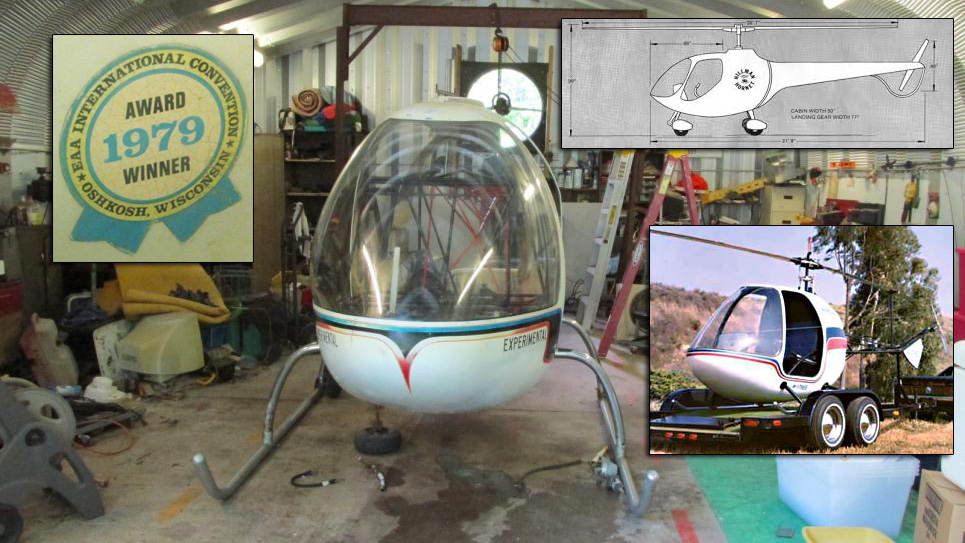

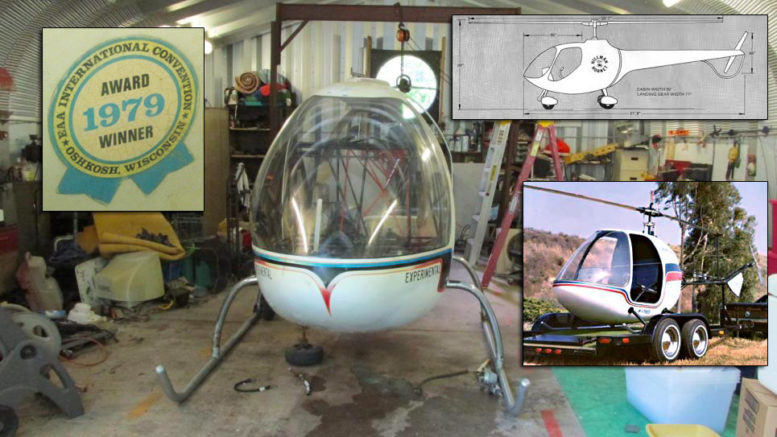
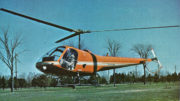
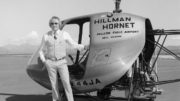
Happy to say the Hillman Hornet N8063D helicopter may soon be legally registered with the FAA. After 5 years, we have tracked down the Estate of Doug Hillman and they are going to sign an FAA bill of sale. We have also already reserved the N# of N8063D for the helicopter. So hopefully soon we will be able to start the restoration. Right now it is torn down to the bare airframe.
WOW! That is amazing news…. We love hearing stories like this, it’s very inspiring to all who live the dream. The Hillman helicopter was one fine machine and we look forward to hearing back from you with updates or possibly a story with pictures we can publish? Make sure you keep a photographic diary of the rebuild, for the FAA, and maybe us??
kind regards, Adam